Prof! What in the world does Formicidae mean and what might it have to do with anatomy? Well, folks, let’s find out. Today’s lesson includes a smidge of entomology, one of my fav college courses, so please read on!
In Starz episode 311, Uncharted, our heroic heroine jumps off Perilous Porpoise into unknown waters, at night no less! Anything to get away from Lousy Lieutenant Leonard!
After reaching land, Claire wanders through sandy scrub terrain seeking signs of human life. Lacking water, food and pretty much every creature comfort, she keeps moving onward. At the end of day one, she stokes a fire with fluff from her homemade bum roll – an impressive bum-roll burn (Image A) . Clever lass; a fie on all bum rolls!!
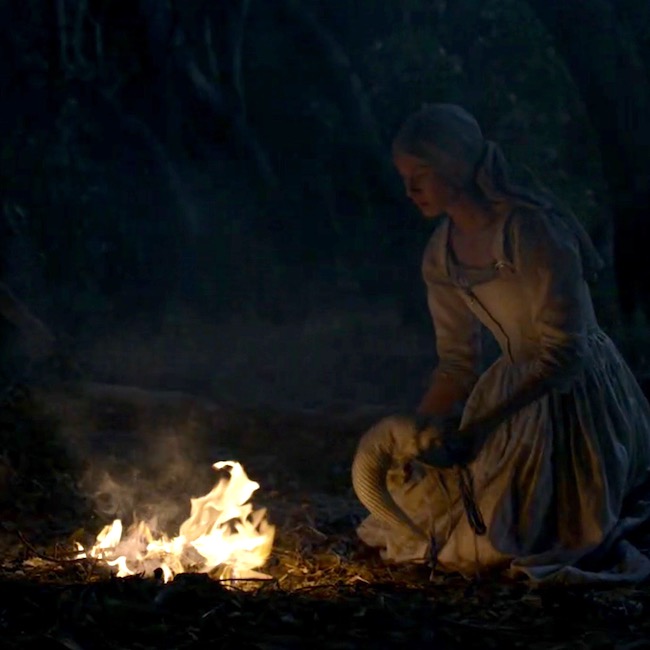
Image A
Next morn, Claire is rudely awakened by a most unpleasant sensation (Image B). What the….????
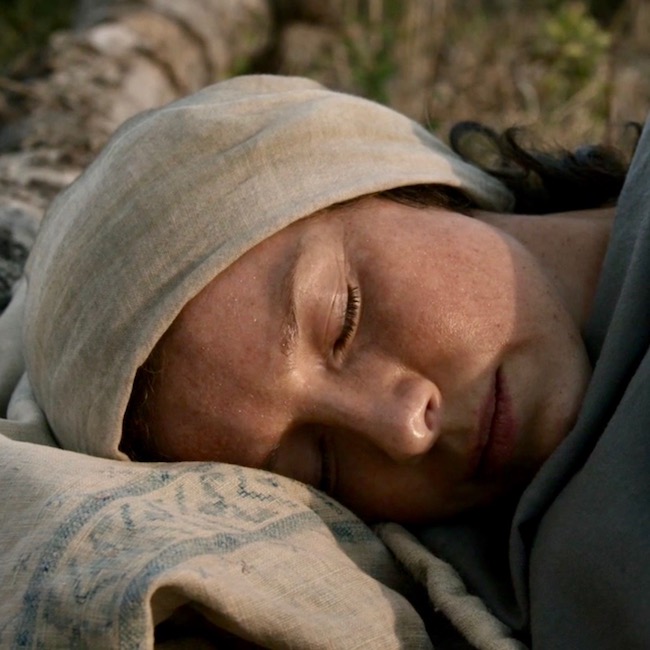
Image B
Claire, wake up! Your gams are covered with busy black beasties (Image C)!
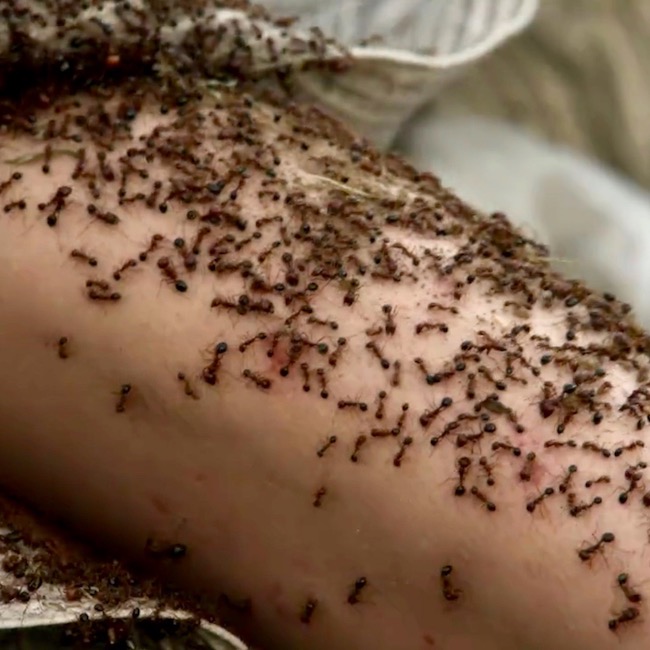
Image C
Claire, get up! Your rest-nest has been messed (Image D)!
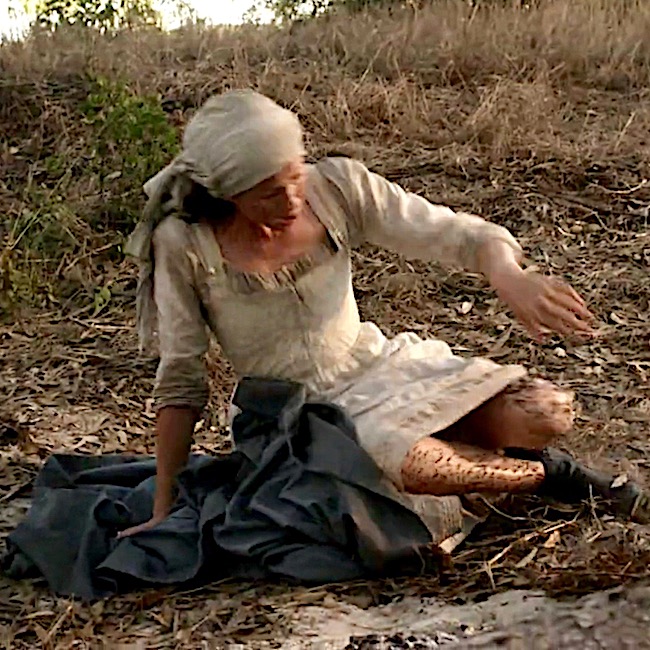
Image D
Whoa! Horrified, Claire slaps at the creepy crawlers to dislodge them from her perfect pins (Image E).
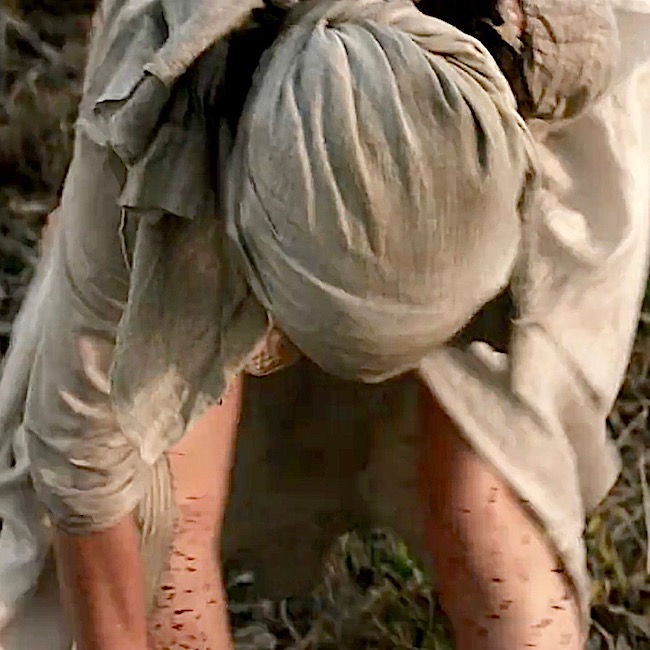
Image E
What in the world happened? Well, unwittingly, Sassynach Surgeon bedded down over creature city, which didn’t care for Claire’s intrusion into its metro boundaries (Image F).
What are these wee demons? If you think ants, you are likely correct. Real ants or CGI magic? We do not ken, but the overall effect was highly convincing! (Psst….update! A reader just shared the 311 script annotation with me and real but harmless ants were used and no ants were harmed in the filming <G>).
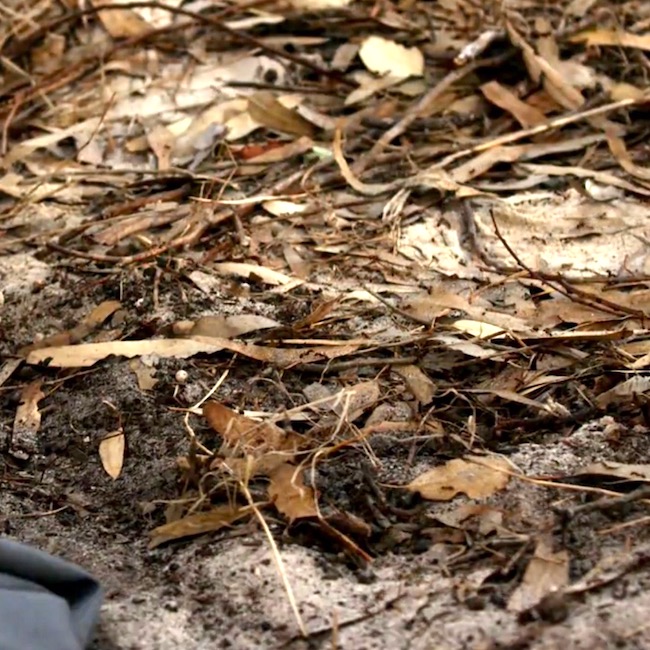
Image F
Classification of Life: Now, dinna run away screaming; this science is verra interesting! All life is divided into increasingly specialized groups (from top to bottom) based upon shared characteristics. In the case of ants, the ranking is:
- Kingdom – Animalia
- Phylum – Arthropoda
- Class – Insecta
- Order – Hymenoptera
- Family – Formicidae <fȯrˈmisəˌdē>
- Genus
- Species
The family name, Formicidae, comes from the Latin formica meaning ant + Greek eidos meaning appearance. (Hehe, this particular formica doesn’t grace kitchen countertops.) This extended family is loaded with some of our fav frenemies: sawflies, wasps, bees and ants! Here are some fascinating facts about ants:
- About 22,000 species of ants roam the earth. We know neither genus nor species of Claire’s attackers – but, stay tuned – a guess is coming up!!
- Ants have elbowed (jointed) antennae and thorn-like nodes at slender waists (Image G – red arrow).
- Most ants form colonies, or superorganisms, because they operate as a unified entity.
- Ants have colonized every continent except Antarctica. Greenland, Iceland, parts of Polynesia, and a few other remote islands also lack native ants.
- The total number of ants alive at any given moment is estimated between 1 and 10 quadrillion; about 10x the biomass of all living mammals! Who knew?
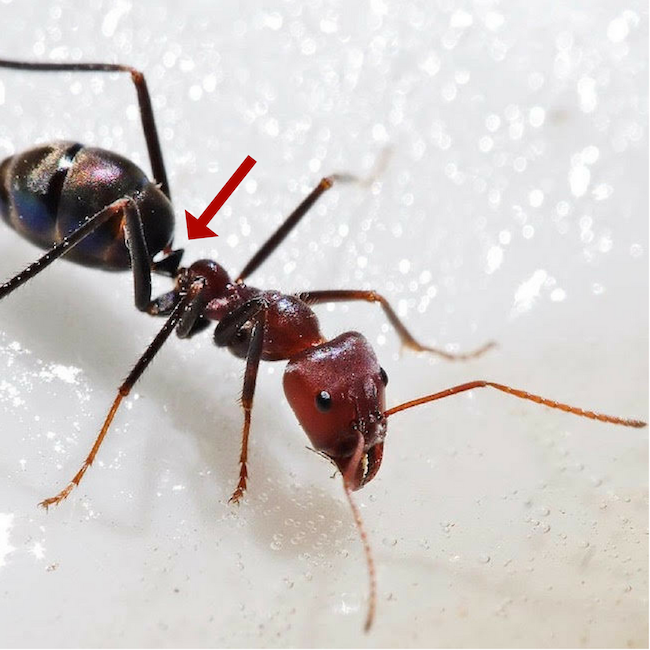
Image G
Truth or Fiction? Did episode 311 pull our collective legs or could Claire truly have had ants-in-her-pants on Hispaniola? Indeed, this tropical tête-à-tête was most certainly feasible!
During the 1700s, eye-witness accounts reported several major ant invasions on Hispaniola and the Lesser Antilles. Ants became so prolific that people placed bedposts in pots of water in an attempt to exclude the party crashers! These accounts describe an ant with a painful bite that lived in colonies near the roots of trees. One current-day entomologist concludes the culprits were tropical fire ants, Solenopsis geminata (genus + species)! Perfect match for Claire’s pesky pests!
Armed with this bit of historical data, I bravely conclude that Courageous Claire likely was attacked by tropical fire ants.
So, what did these pests do to Claire’s loooong lovely limbs (Image H)?
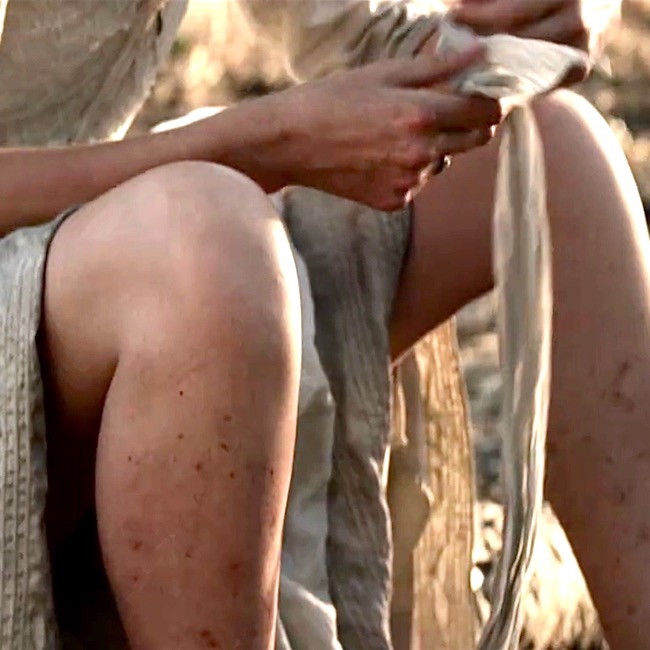
Image H
To Bite or to Sting? To bite or not to bite, that is the question! Some ants, such as the North American carpenter ant, sink mandibles (jaws) into their victims, delivering formic acid via the bite. But, other ants deliver venom via stingers! The venom is an alkaloid, a class of powerful compounds including morphine, atropine, etc. Such venom is potent and capable of producing anaphylaxis in those who have developed sensitivity to the venom.
Fire ants fall into the latter category; they are aggressive, venomous insects with pinching mandibles on the head and sharp stingers at the rear which, in turn, are connected to internal venom sacs. Take a wee keek at that stinger (Image I). Och!
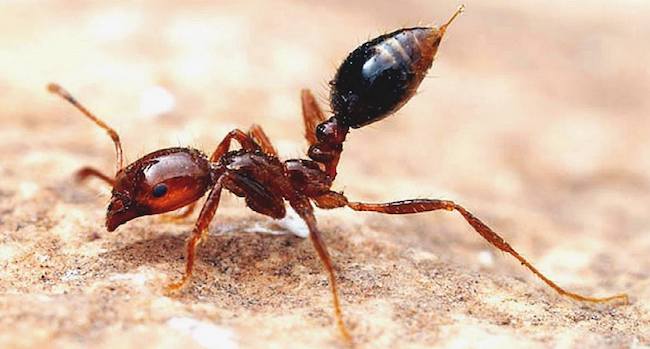
Image I
Bite and Sting: So, get this: fire ants deliver an impressive coup de grâce because they bite and sting (Image J). Gasp!
Disturbed, as in an exhausted woman sleeping on their nest, fire ants grip the skin with paired mandibles, pierce the epidermis with stingers and deliver venom into the dermis (Anatomy Lesson #5, Claire’s Skin – Opals, Ivory and White Velvet)! Feet or legs are most often stung, usually after accidentally stepping on a fire ant mound. So, Claire was the perfect victim for a swinging-stinging fire ant soiree!
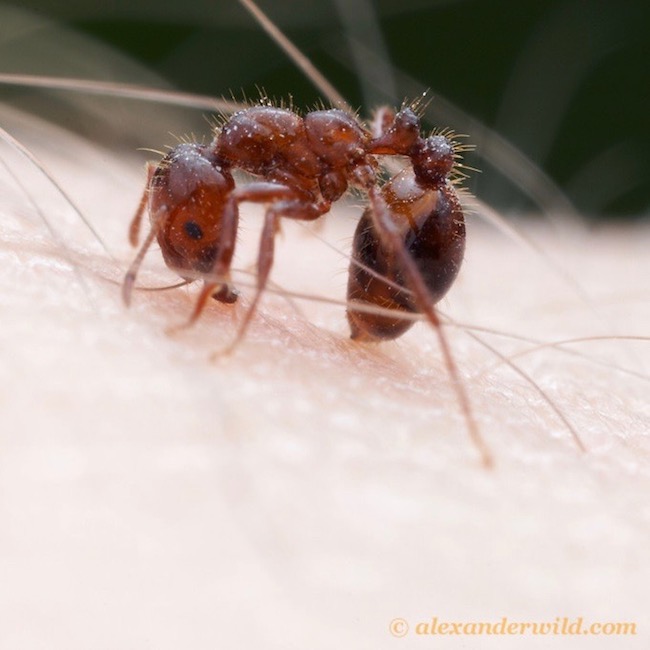
Image J
And, should you choose to witness the little buggers in action, here is a fine example via YouTube:
What to do? Back at the island, Claire slaps and brushes the pests to dislodge them (Image K).
Is this a good idea? Some sources recommend killing fire ants by slapping them off your body, although they don’t die that easily. Others don’t recommend slapping because it further enrages the beasties. Probably best to pick them off or brush them away, although this is a challenge with clingly-Klingons, especially when they attack en masse!
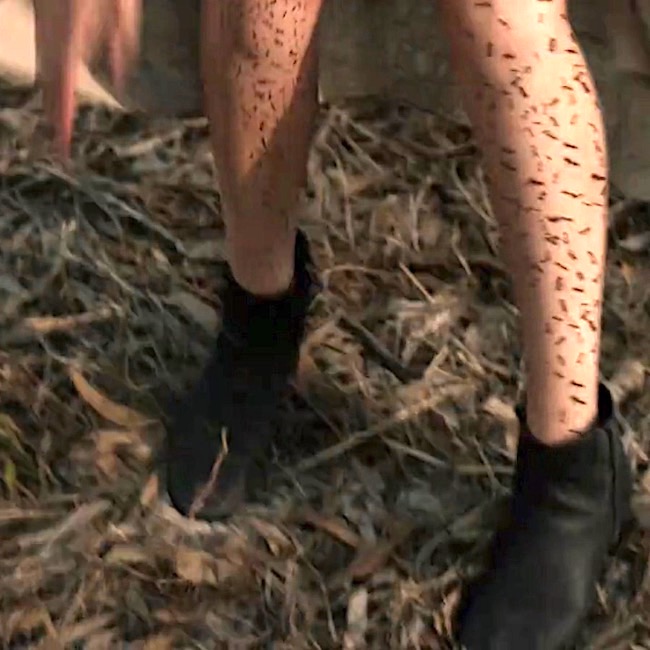
Image K
Things to do for Relief:
- Elevate affected area – Nope! Claire canna stop to elevate her legs; she must keep moving to find help for Jamie and herself!
- Bathe stings with soapy water – No soap, much less water, available for cleansing stings; our lass is dying of thirst, here!
- Use a cold compress or ice – If only!
- Take an antihistamine or apply a hydrocortisone cream – Not on 18th century Hispanola!
So, Claire does the next best thing! After slapping away her tormentors, she assesses the red lesions covering her splendid shanks (Anatomy Lesson #27, Colum’s Legs and Other Things, Too!). She rips strands of fabric (18th century shifts come in mighty handy – <G>) to wrap her limbs (Image L). This helps keep air away from the wounds thereby lessening skin irritability and protecting the bumps from further depredation as she trudges through rough tropical vegetation.
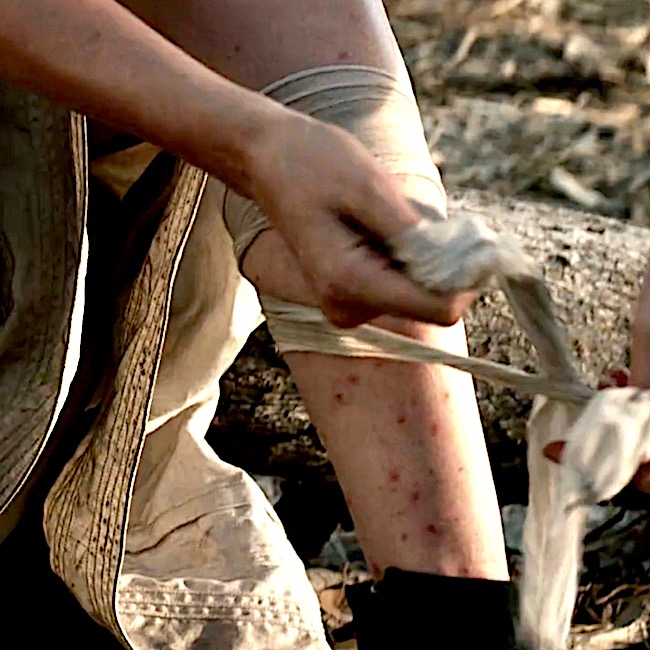
Image L
Then What Happens? Usually fire ant stings cause small, itchy lumps which resolve within a few hours. But, occasionally, the lumps turn into blisters filled with a fluid that looks like pus. Such is the fate of Claire’s fiery stings.
Much later, dragging through the tropical forest, she checks her legs and, oh sweet Claire, what will Jamie say!!!! Her red bumps have converted into swollen, fluid-filled pustules that itch (Image M)! The pus-like fluid is a mixture of dead cells – a local demolition derby caused by the venom. Although such an intense local reaction occurs less often, the pustules are very obtrusive and extremely uncomfortable!
Disoriented from lack of water, thoroughly traumatized and alone, Claire scratches the pustules. No, Claire, dinna do that! Scratching breaks the skin barrier, leaving underlying tissues vulnerable to secondary infection. Remember, your penicillin is far far away, floating on the Artemis with Big Red.
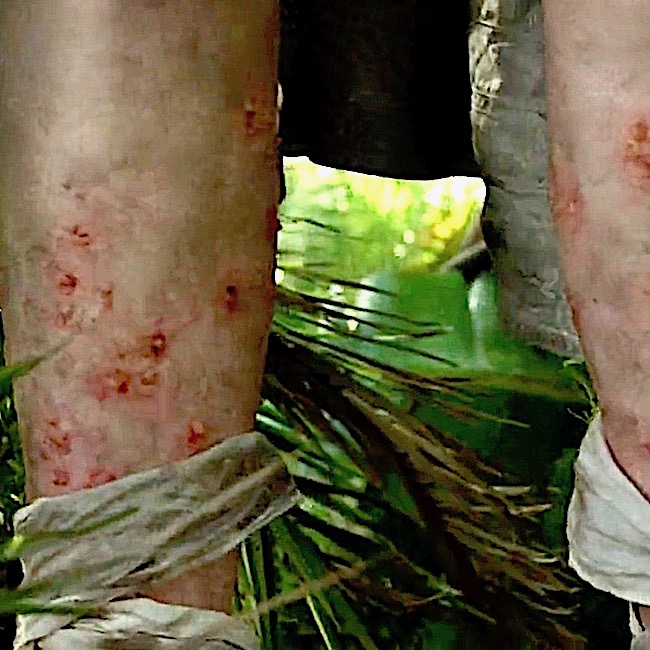
Image M
After Ludo – bless his wee doggie heart – finds Claire on a path, she awakens tied to a bed, her legs covered with greenish matter and she is damned thirsty. Gimme water!
Prickly Mamacita ‘splains: “This was the only way to keep you from scratching.” As inhospitable as Mamacita is, she is spot-on about the scratching bit. The pustules are itchy and uncomfortable but, as mentioned above, scratching can induce secondary infection, even ulceration and scarring!
Green Poultice: I immediately thought of aloe vera when the green goo came into view – a plant that could offer some soothing relief. But, unfortunately, aloe vera was not introduced to Hispanola until the 19th century, 100 years in the future. So nada aloe for our suffering sassenach! Abiding history, possibly a clay poultice or some other macerated plant matter might have been applied for relief. Whatever it is, the sting lesions resolve shortly and she resumes “earnestly seeking Jamie.”
BTW, kudos to Father Fogden for exhibiting gentlemanly behavior while helping Claire to a seated position (Image N). Well done, Father!
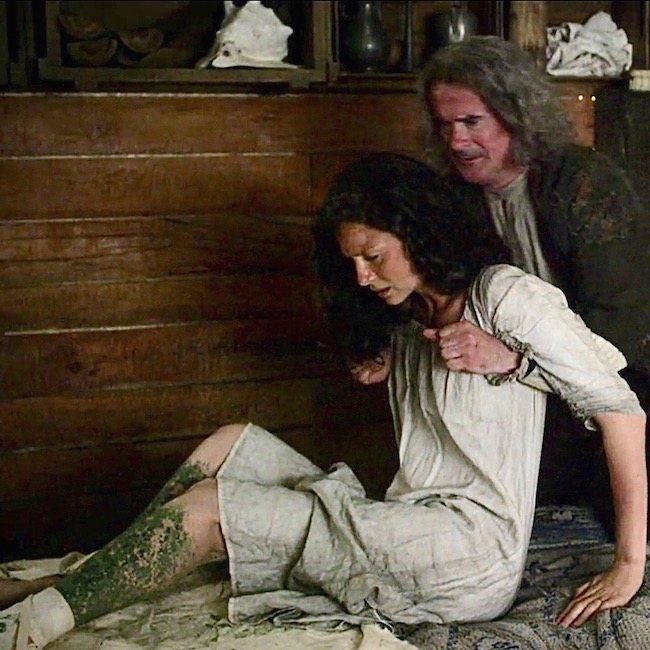
Image N
True Story: Some years ago, I lived adjacent to Buffalo Bayou in Houston, Texas, where cutting grass often is an absolute necessity. One fine summer day, wearing shorts and halter, I was mowing. Industriously tamping out grass collected in the mower bag, I tucked it under my arm to re-zip. Yikes, my oxter suddenly was on fire! Hah! Well, not really. Rather, my arm pit was filled with a writhing mass of wee nasty fire ants. Rushing to the faucet, I tried washing them off. A bad idea, as the water irritated them even more. Like Claire, I finally brushed them from my abused pit with my free hand!
There is good reason why these beasties are called fire ants – the wounded area burns and stings like the dickens! Soon, the burning gives way to serious itching. My stings never turned into the large pustules that Claire suffered, but, I now know that during the summer, fire ants develop the greatest load of venom and therefore the stings are largest and most painful.
Warning! Keep your distance from fire ant mounds!
Image O illustrates the side of a knee covered with multiple fire ant lesions, giving you a keen idea of pustules, courtesy of fire ants!
Moral to the Story: Be careful where you tamp your grass! <G>
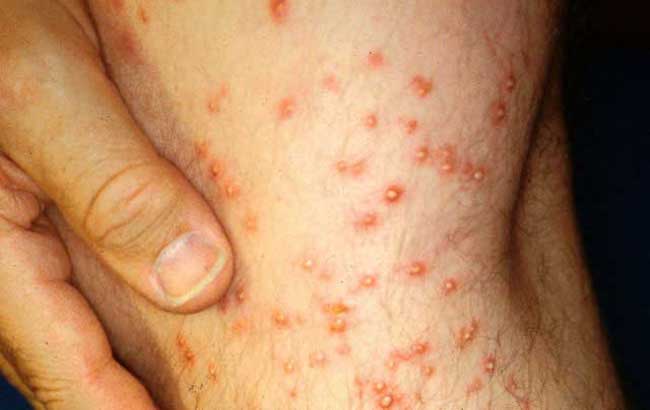
Image O
Always Pests? Ants are routinely treated as pests because they don’t offer a lot of plusses. But, did you know they aid soil aeration and decomposition by digging tunnels and turning over the dirt? Further, in Africa and South America, ants provide surgical sutures. There, wound margins are pressed together and ants applied. The ant seizes the edges of the wound with its mandibles (jaws) and locks them in place. The body is pinched off but head and mandibles remain closed until the wound heals.
George Washington Williams (Samuel L. Jackson) applied ant mandibles to Tarzan’s (Alexander Skarsgȯrd) bite wound, in the 2016 film, The Legend of Tarzan. Yep, those black bumps are ant heads and mandibles (Image P)!

Image P
So, in episode 311, Claire faced a formidable Formicidae foe in the form of tropical fire ants. Not only did her legs burn, the sting wounds could have become secondarily infected, ulcerated and scarred. Or worse, she might have experienced anaphylactic shock from the fire ant venom, with no Jamie to rescue her!
The terrific ant scene was written for TV Outlander only, as it does not appear in Diana’s Voyager book. However, in this splendid book, stranded Claire encounters red-throated birds (Portugese-man-of-war birds?), tiny purple crabs, fish that walk on pectoral fins and appear to have four eyes, and one “Lawrence Stern, Doctor of Natural Philosophy, of the Gesellschaft von Naturwissenschaft Philosophieren, Munich.” Diana always provides such imaginative detail, we readers feel as if we are there with Claire. Thank you, Diana!
Claire the Girl Scout: Now, I must close with a special note of praise for Claire; despite stinging legs, desperate thirst, exhaustion and being lost, like a responsible camper, the good lass took time to douse her bum fire with sand (Image Q). A fine example to us all. Go, Smokey-the-Bear, Claire!
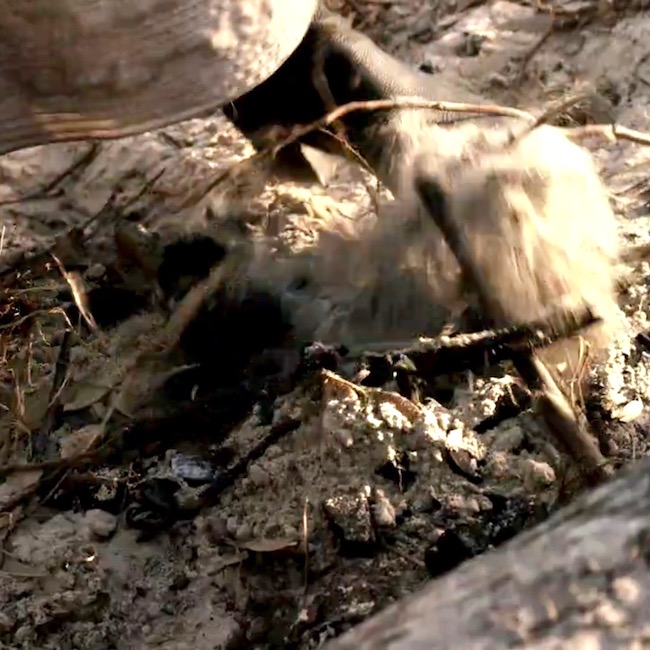
Image Q
The deeply grateful,
Outlander Anatomist
Photo Creds: Starz, Outlander episode 311, Uncharted (Images A-F, H, K-N, Q); www.alexanderwild.com (Image J – fire ant stinging); www.en.wikipedia.org (Image G – ant node); www.bluebird-electric.net (Image I – fire ant stinger); www.healcure.org (Image O – fire ant stings); www.wegotthiscovered.com (Image P – Tarzan)

The scripts for season 3 of Outlander are available at the Outlander Community website, in the “Inside Outlander” section. They’re fascinating.
Excellent Janet! TY so much! This is terrific as I have to guess without this type of inside info. I shall check there in the future to read about special effects.
Have a lovely holiday season!
Marvelous information, TY.
An also deeply grateful fan.
Oh, Moz! What a lovely comment. Thank you! I am glad it was interesting.
Have a wonderful holiday season!
An annotation from the script for this episode on the Outlander Community site states:
“Karen Campbell Annotation
Fire ants! Not really. Just hundreds of non-biting ants that we cast as fire ants. Our insect wrangler, Ryan, brought it big time with not only multitudes of ants (which were not harmed during filming), but also other fun critters —beetles, snakes, goats…”.
Just so you know. . . ?
Dear Lisa:
Thanks for the script annotation from Karen Campbell. Would like to know how to find those. Can you share?
Of course, not real fire ants were used on Cait. That would cruel and inhumane! 🙂 Plus the ants shown were far too large and wrong color for real fire ants. They are very tiny with reddish heads.
I just didn’t know if real ants were used, but I do know now.
Loved that the ants weren’t harmed during the filming.
I saw a pic/clip of the snake and Cait which I assume was also Ryan to the rescue.
Thanks for taking the time to read and to write. Happy holidays!